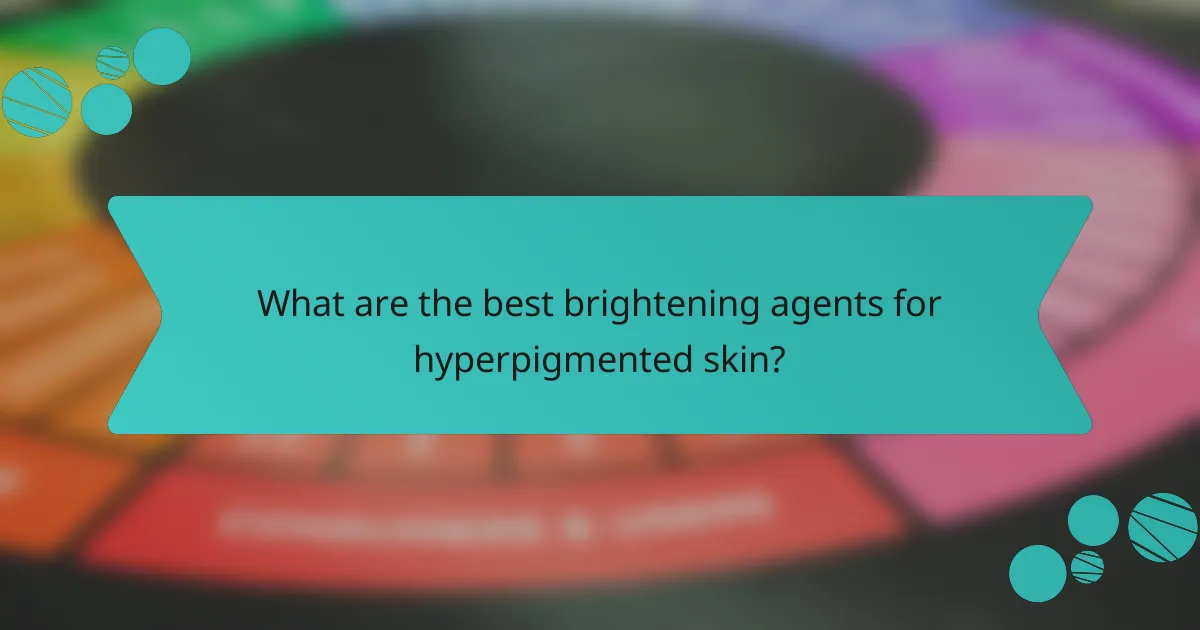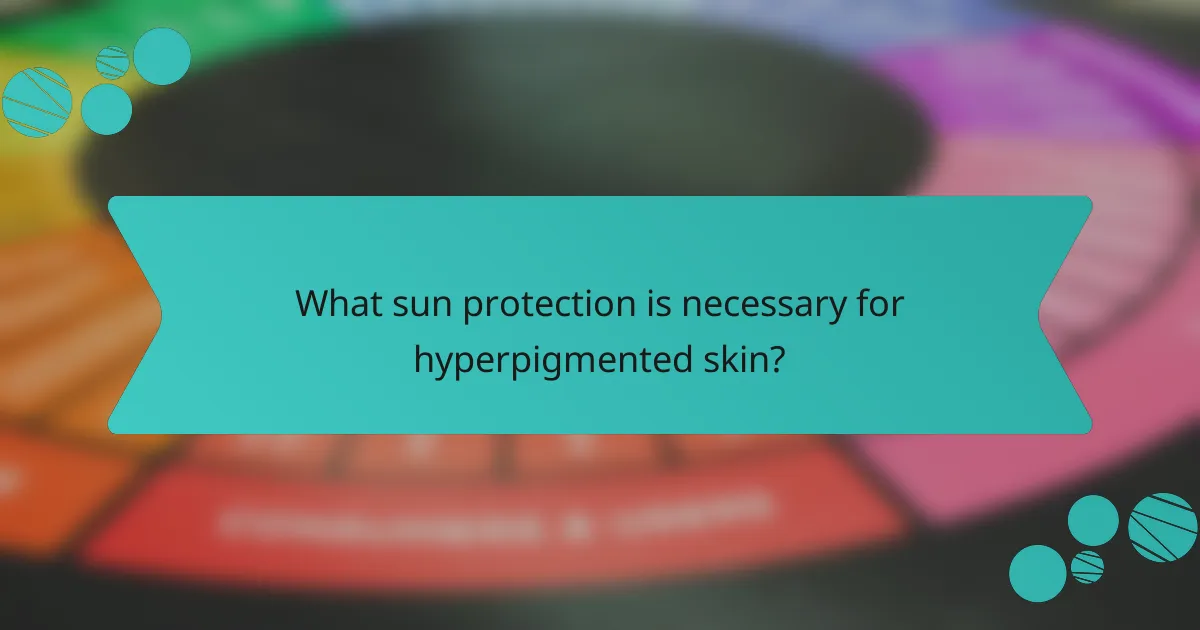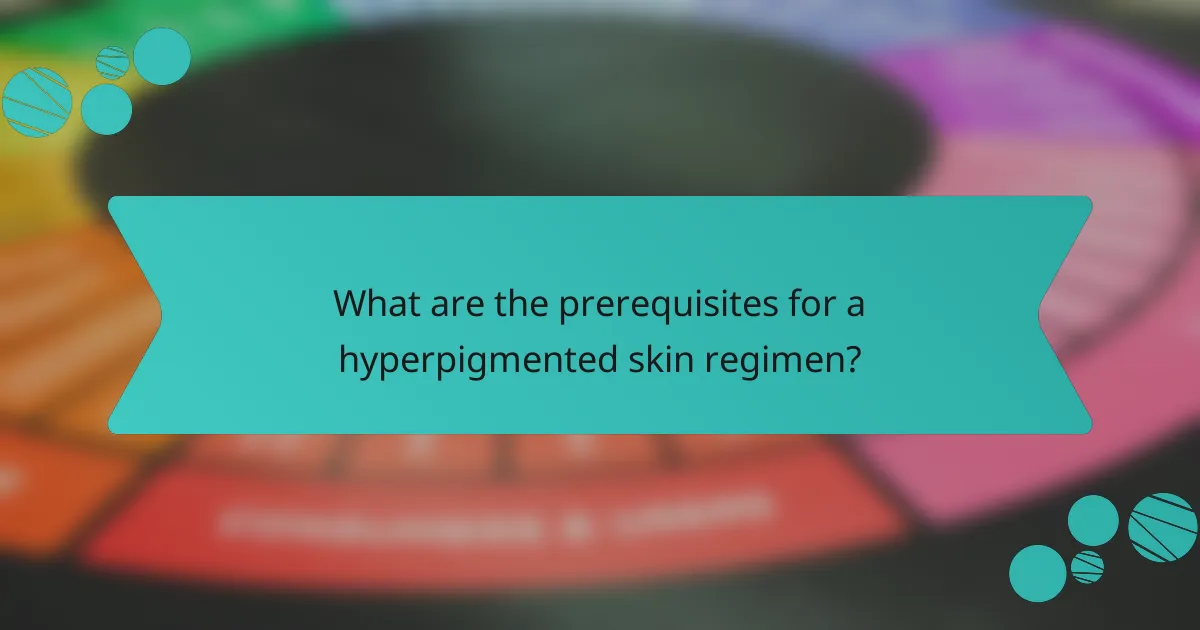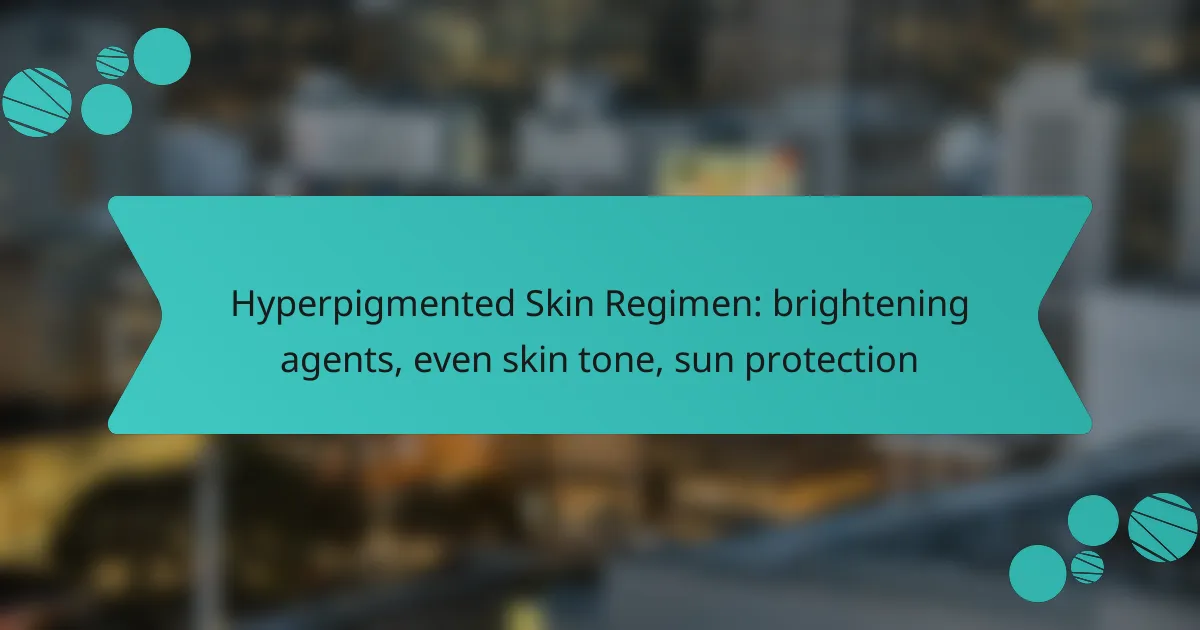Managing hyperpigmented skin requires a thoughtful regimen that incorporates effective brightening agents such as Vitamin C, Niacinamide, and Retinoids to reduce dark spots and enhance radiance. Consistent exfoliation and diligent sun protection are also crucial in achieving an even skin tone and preventing further discoloration. By prioritizing these elements, you can work towards a more uniform and luminous complexion.

What are the best brightening agents for hyperpigmented skin?
The best brightening agents for hyperpigmented skin include Vitamin C, Niacinamide, Hydroquinone, Azelaic Acid, and Retinoids. These ingredients help to reduce dark spots, even skin tone, and improve overall radiance.
Vitamin C serums
Vitamin C serums are powerful antioxidants that can brighten skin and reduce hyperpigmentation. They work by inhibiting melanin production and protecting the skin from UV damage. Look for serums with concentrations between 10% and 20% for optimal results.
When using Vitamin C, apply it in the morning before sunscreen for enhanced protection. Be cautious of product stability; choose formulations in opaque or dark containers to maintain efficacy.
Niacinamide creams
Niacinamide, or Vitamin B3, is known for its ability to even skin tone and improve texture. It helps to reduce the appearance of dark spots and can enhance the skin’s barrier function. Creams with 5% to 10% concentration are commonly effective.
This ingredient is generally well-tolerated and can be used alongside other treatments. Incorporate it into your nighttime routine for the best results, and consider patch testing if you have sensitive skin.
Hydroquinone treatments
Hydroquinone is a potent skin-lightening agent that can significantly reduce hyperpigmentation. It works by inhibiting the enzyme responsible for melanin production. Over-the-counter products typically contain up to 2% hydroquinone, while stronger formulations may require a prescription.
Use hydroquinone for a limited duration, typically no longer than three months, to avoid potential side effects like skin irritation. Always follow up with sunscreen, as hydroquinone can make skin more sensitive to sunlight.
Azelaic acid products
Azelaic acid is a multifunctional ingredient that helps to brighten skin and reduce inflammation. It works by inhibiting melanin production and can also treat acne. Products containing 10% to 20% azelaic acid are effective for hyperpigmentation.
This ingredient is suitable for sensitive skin and can be used both morning and night. It is often found in creams and gels, making it easy to incorporate into your skincare routine.
Retinoids
Retinoids, derivatives of Vitamin A, are effective for treating hyperpigmentation by promoting cell turnover and encouraging the growth of new skin. They can help fade dark spots and improve overall skin texture. Over-the-counter options like retinol are available, while stronger retinoids may require a prescription.
Start with a low concentration to assess tolerance, applying it at night and gradually increasing usage. Always pair retinoids with sunscreen during the day, as they can increase sun sensitivity.

How to even skin tone effectively?
To effectively even skin tone, incorporate a regimen that includes brightening agents, consistent exfoliation, and sun protection. This approach helps reduce hyperpigmentation and promotes a more uniform complexion.
Consistent use of exfoliants
Regular exfoliation is crucial for removing dead skin cells and promoting cell turnover, which can help even out skin tone. Consider using chemical exfoliants like alpha hydroxy acids (AHAs) or beta hydroxy acids (BHAs) two to three times a week.
Physical exfoliants can also be beneficial but should be used with caution to avoid irritation. Always follow up with a moisturizer to maintain hydration and protect the skin barrier.
Incorporating chemical peels
Chemical peels can provide deeper exfoliation and are effective in treating hyperpigmentation. Depending on the strength, they can be performed every few weeks to monthly, depending on your skin’s tolerance.
Look for peels containing glycolic acid or salicylic acid, and consult a dermatologist to determine the best type for your skin type and concerns. Post-peel care is essential to protect the skin as it heals.
Daily moisturizing routines
Hydration plays a key role in achieving an even skin tone. Use a moisturizer that contains ingredients like hyaluronic acid or glycerin to lock in moisture and support skin barrier function.
Incorporate a broad-spectrum sunscreen with at least SPF 30 into your daily routine to protect against UV damage, which can worsen hyperpigmentation. Reapply every two hours when outdoors for optimal protection.
Using targeted treatments
Targeted treatments with ingredients such as vitamin C, niacinamide, or licorice root extract can help brighten the skin and reduce dark spots. Apply these treatments directly to affected areas for maximum effect.
Consistency is key; use these products daily for several weeks to see noticeable improvements. Always patch test new products to avoid adverse reactions, especially if you have sensitive skin.

What sun protection is necessary for hyperpigmented skin?
For hyperpigmented skin, broad-spectrum sun protection is essential to prevent further discoloration and promote an even skin tone. Using sunscreens with adequate SPF and reapplying them regularly can significantly reduce the risk of exacerbating hyperpigmentation.
Broad-spectrum SPF 30 or higher
Choosing a broad-spectrum sunscreen with an SPF of 30 or higher is crucial for protecting hyperpigmented skin. This level of protection blocks about 97% of UVB rays, which are primarily responsible for skin damage and pigmentation changes. Look for products labeled as “broad-spectrum” to ensure they protect against both UVA and UVB rays.
When selecting a sunscreen, consider formulations that include additional skin-beneficial ingredients, such as antioxidants, to further combat free radical damage. Regular use can help maintain an even skin tone and prevent new dark spots from forming.
Physical vs. chemical sunscreens
Physical sunscreens contain active mineral ingredients like zinc oxide or titanium dioxide, which sit on the skin’s surface to reflect UV rays. They are often recommended for sensitive or hyperpigmented skin because they are less likely to cause irritation and provide immediate protection upon application.
Chemical sunscreens, on the other hand, absorb UV radiation and convert it into heat, which is then released from the skin. While they can be effective, some individuals with hyperpigmentation may find them irritating. Testing both types can help determine which works best for your skin.
Reapplication guidelines
Reapplying sunscreen is vital for effective protection against hyperpigmentation. It is generally recommended to reapply every two hours, especially if you are sweating or swimming. For daily use, consider using a setting spray or powder sunscreen for convenience.
In situations of prolonged sun exposure, such as outdoor activities, reapply more frequently, ideally every hour. Keeping a travel-sized sunscreen handy can help ensure you stay protected throughout the day.

What are the prerequisites for a hyperpigmented skin regimen?
To effectively manage hyperpigmented skin, it’s essential to understand your skin type and consult with a dermatologist. These steps ensure that the chosen regimen is tailored to your specific needs and conditions.
Skin type assessment
Assessing your skin type is crucial for selecting the right products and treatments for hyperpigmentation. Skin types generally fall into categories such as oily, dry, combination, and sensitive. Each type reacts differently to various ingredients, making this assessment a foundational step.
Consider conducting a simple test: after cleansing, observe how your skin feels after a few hours. If it feels tight, you likely have dry skin; if it appears shiny, you may have oily skin. This understanding will guide you in choosing suitable brightening agents.
Consultation with a dermatologist
Consulting with a dermatologist is vital for developing an effective hyperpigmented skin regimen. A professional can provide personalized advice based on your skin type, the severity of pigmentation, and any underlying conditions. They may recommend specific treatments or products that are safe and effective for your skin.
During your consultation, be prepared to discuss your skin history, lifestyle factors, and any previous treatments you’ve tried. This information will help your dermatologist create a tailored plan, which may include topical agents, chemical peels, or laser treatments, depending on your needs.

How to choose products for hyperpigmented skin?
Choosing products for hyperpigmented skin involves selecting formulations that contain effective brightening agents, promote an even skin tone, and provide adequate sun protection. Look for ingredients known to reduce dark spots and prevent further discoloration while ensuring compatibility with your skin type.
Ingredient analysis
When analyzing ingredients for hyperpigmented skin, focus on those with proven efficacy in brightening and evening out skin tone. Key ingredients include vitamin C, kojic acid, niacinamide, and licorice extract, which help inhibit melanin production and enhance skin radiance.
Additionally, consider exfoliating agents like alpha hydroxy acids (AHAs) and beta hydroxy acids (BHAs) that can promote cell turnover and fade dark spots over time. Always check for formulations that also include sun protection, as UV exposure can exacerbate hyperpigmentation.
Be cautious of potential irritants in products, especially if you have sensitive skin. Start with lower concentrations of active ingredients and gradually increase usage to avoid adverse reactions. A patch test is recommended before applying new products to your entire face.
